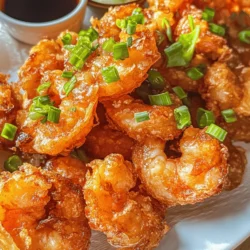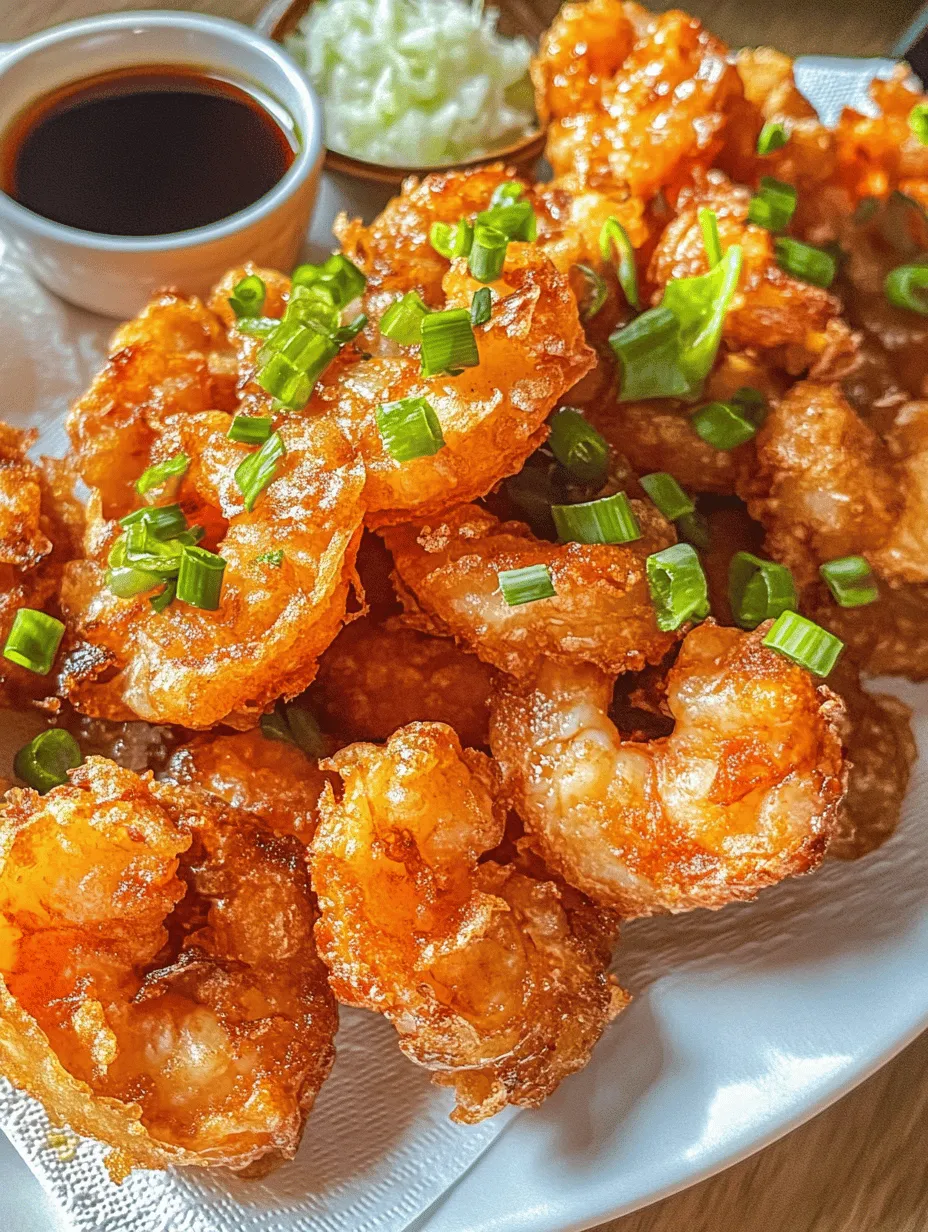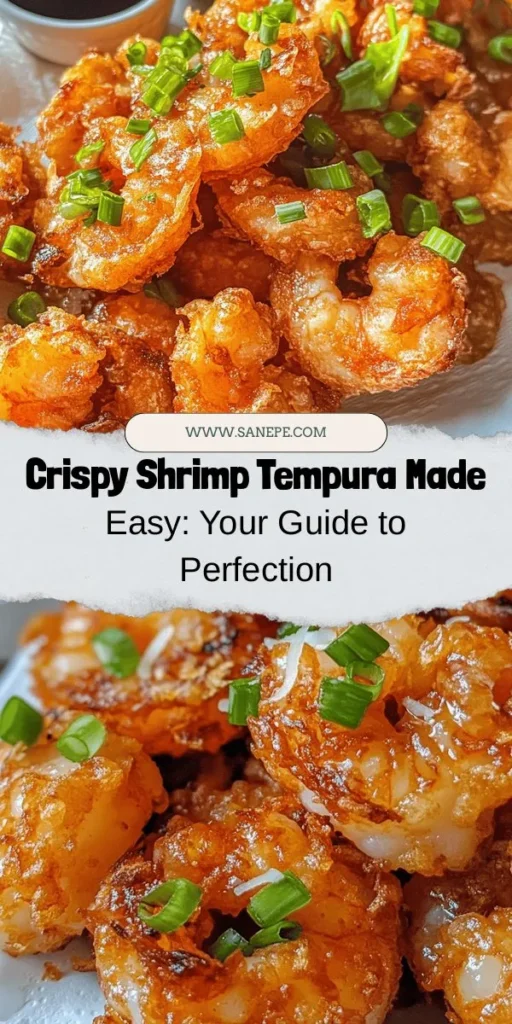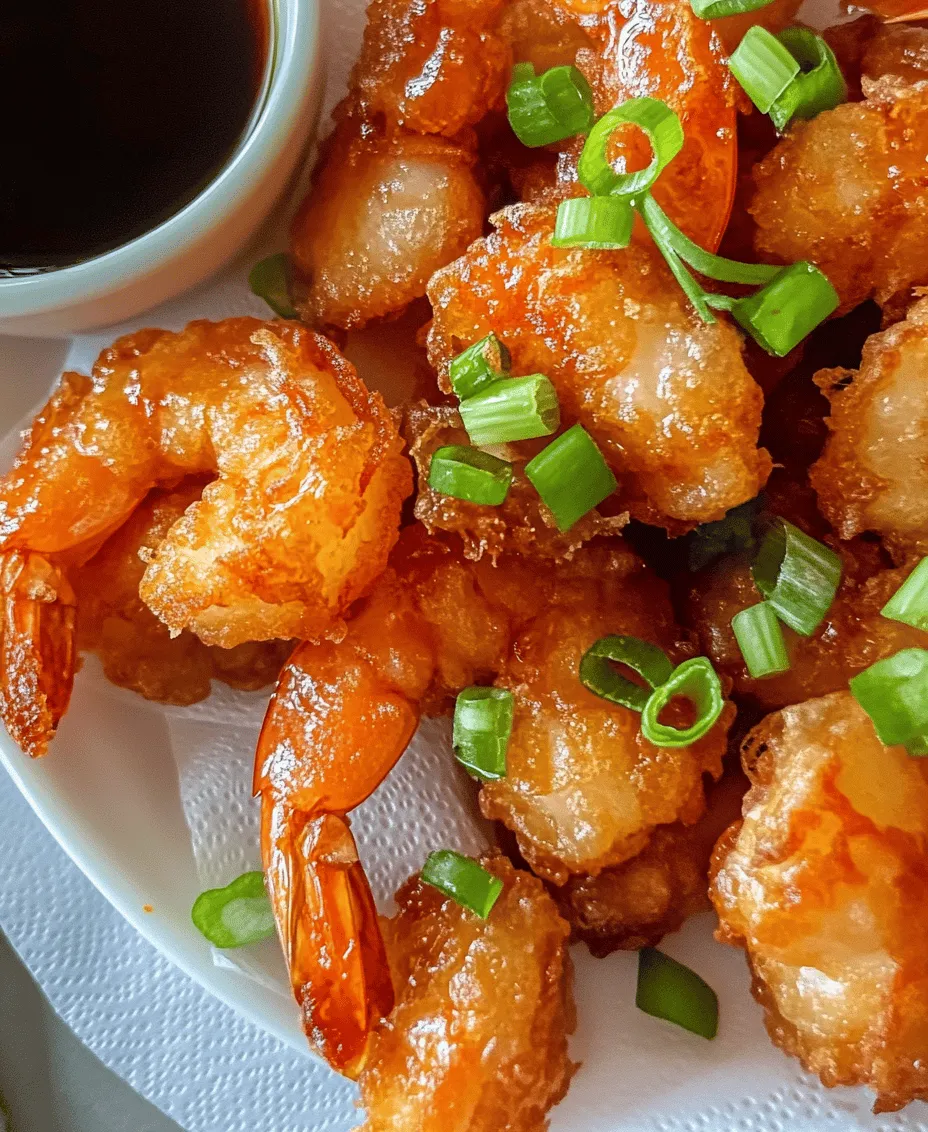Introduction
Shrimp tempura is a beloved dish that embodies the essence of Japanese cuisine, showcasing a delightful combination of tenderness and crunch. Known for its light and airy texture, this popular dish has made its way from the streets of Japan to dining tables around the world. The secret to the perfect shrimp tempura lies in achieving an impeccable crispy coating that envelops succulent shrimp, making each bite a delightful experience. In this article, we will delve into the intricate world of shrimp tempura, exploring its background, essential ingredients, and step-by-step preparation for creating this culinary masterpiece at home.
As we embark on this culinary journey, readers can expect to discover detailed recipe instructions, expert cooking techniques, and creative serving suggestions that will elevate their tempura game. Whether you are a novice cook or a seasoned chef, this guide will equip you with the knowledge and skills needed to prepare crispy shrimp tempura that will impress your family and friends.
Understanding Shrimp Tempura
Historical Background of Tempura in Japanese Cuisine
The origins of tempura can be traced back to the 16th century when Portuguese Jesuit missionaries introduced the technique of frying food in batter to Japan. Initially, this cooking method was used to prepare fish and vegetables during Lent, a period of fasting. Over time, the Japanese adapted the technique, incorporating local ingredients and flavors, ultimately leading to the creation of the beloved dish we know today as tempura.
Tempura’s popularity quickly grew throughout Japan, and by the Edo period (1603-1868), it had become a staple in Japanese cuisine. Street vendors began to sell tempura, making it accessible to everyone. Today, tempura is not only enjoyed in Japan but has also gained international acclaim, finding its way into numerous global restaurants and households.
Tempura’s Significance and Popularity Worldwide
Tempura has transcended its humble beginnings to become a symbol of culinary finesse in Japanese cuisine. Its appeal lies not only in its delicious taste but also in its unique cooking method, which preserves the natural flavors and textures of the ingredients. The light, crispy batter allows the shrimp and vegetables to shine, making tempura a favorite among food enthusiasts.
In recent years, tempura has seen a resurgence in popularity, with chefs around the world experimenting with various ingredients and flavors. From traditional shrimp and vegetables to innovative variants such as sweet potato or even ice cream, tempura continues to evolve while remaining true to its roots.
Components and Variations of the Dish
At its core, shrimp tempura consists of two primary components: the shrimp and the batter. The shrimp, typically large and juicy, are the star of the dish, while the batter provides the signature crunch. While the classic version features shrimp, tempura can also include a variety of vegetables, such as bell peppers, zucchini, and eggplant, all of which can be prepared in the same light and crispy style.
In addition to the classic shrimp tempura, there are numerous variations to explore. Some cooks add flavorings to the batter, such as paprika or herbs, to give it a unique twist. Others experiment with different types of seafood or plant-based proteins to create a diverse range of tempura options that cater to various dietary preferences.
Ingredients Breakdown
Overview of Essential Ingredients
To create the perfect shrimp tempura, it is vital to gather high-quality ingredients that contribute to the dish’s overall flavor and texture. The key components include:
– Large shrimp
– All-purpose flour
– Cornstarch
– Sparkling water
– Salt
– Dipping sauces (traditional soy sauce, tentsuyu, or modern variations)
Each ingredient plays an important role in achieving the desired results, making it essential to understand their contributions before diving into the cooking process.
Importance of Each Ingredient in Achieving Perfect Tempura
1. Large Shrimp: The star of the dish, large shrimp should be fresh and firm. When selecting shrimp, look for those with a translucent, slightly grayish color and a clean, oceanic scent. Avoid shrimp that have a strong fishy odor or are overly mushy. Proper preparation, including deveining and peeling, is crucial for the best flavor and texture.
2. Flour and Cornstarch: The combination of all-purpose flour and cornstarch is fundamental in creating the crisp texture of tempura batter. The flour provides structure, while the cornstarch contributes to a lighter, crunchier finish. This unique blend helps to absorb moisture and create a barrier that keeps the shrimp juicy while frying.
3. Sparkling Water: The use of sparkling water (or club soda) in the batter is a game-changer. The carbonation helps to create air bubbles, resulting in a light and crispy texture when fried. Additionally, the cold temperature of the sparkling water helps maintain the integrity of the batter during cooking.
4. Salt: A pinch of salt is essential for enhancing the flavors of the batter and the shrimp. It helps balance the dish and brings out the natural sweetness of the seafood.
5. Dipping Sauces: Traditional dipping sauces, such as soy sauce or tentsuyu (a dipping sauce made from dashi, soy sauce, and mirin), complement the tempura perfectly. Modern variations may include spicy mayo or even fruit-infused sauces, adding a creative touch to your meal.
Large Shrimp: Selection and Preparation Tips
When it comes to selecting shrimp for tempura, size matters. Look for large shrimp, typically labeled as U10 or U12, which indicates the number of shrimp per pound. These larger shrimp not only provide a satisfying bite but also hold up well in the frying process.
Before cooking, proper preparation is key. Start by peeling the shrimp, leaving the tails on for presentation. Next, devein the shrimp by making a shallow cut along the back and gently removing the dark vein. To ensure even cooking and a pleasing appearance, you can make shallow cuts along the belly of the shrimp to prevent curling during frying. Finally, rinse the shrimp under cold water and pat them dry with paper towels to remove excess moisture.
Flour and Cornstarch: Role in Creating the Batter’s Texture
The batter is crucial for achieving the signature crispiness of shrimp tempura. The ideal batter should be light and lumpy, allowing it to adhere well to the shrimp without becoming overly dense. The combination of all-purpose flour and cornstarch creates a delicate balance: the flour adds structure, while the cornstarch ensures a light, crunchy texture.
When preparing the batter, it is essential not to overmix. A lumpy batter is a good sign, as it traps air bubbles that will help create the desired crispiness when fried. This unique texture is what sets tempura apart from other fried dishes and is a hallmark of a well-executed recipe.
Sparkling Water: How It Contributes to Crispiness
The inclusion of sparkling water is one of the secrets to achieving perfectly crispy tempura. The carbonation in sparkling water creates air bubbles in the batter, which expand during frying, resulting in a light and airy texture. Additionally, using cold sparkling water helps maintain the temperature of the batter, preventing gluten development and ensuring a tender coating.
For the best results, use very cold sparkling water, and add it to the dry ingredients just before frying. This technique will yield a tempura batter that is not only crispy but also incredibly satisfying.
Dipping Sauces: Traditional Options and Modern Variations
No shrimp tempura is complete without a delicious dipping sauce. Traditionally, tempura is served with tentsuyu, a savory sauce made from dashi (a Japanese soup stock), soy sauce, and mirin (a sweet rice wine). This sauce complements the flavor of the tempura while adding an umami kick.
For those looking to experiment, modern variations of dipping sauces include spicy mayo, which combines mayonnaise with sriracha or wasabi, or fruit-infused sauces that provide a refreshing contrast to the savory shrimp. Whether you stick to tradition or explore new flavors, the right dipping sauce can elevate your shrimp tempura experience.
Preparation Steps for Perfectly Crispy Shrimp Tempura
Preparing the Shrimp
As we’ve established, the preparation of the shrimp is crucial for the success of your tempura. Begin by selecting fresh, large shrimp and thoroughly cleaning them. Peel and devein as described earlier, and then dry the shrimp with paper towels. This step is essential, as excess moisture can lead to a soggy batter that defeats the purpose of crispy tempura.
Once the shrimp are prepped, season them lightly with salt. This not only enhances their natural flavor but also helps to draw out any additional moisture, ensuring the batter adheres properly during frying.
Importance of Drying Shrimp and Seasoning
Drying the shrimp is a vital step in achieving the perfect tempura. Wet shrimp can lead to a batter that slips off during frying, resulting in a less-than-ideal texture. Patting the shrimp dry allows for better adherence of the batter, which in turn leads to a crispier final product.
Seasoning the shrimp with a touch of salt not only enhances flavor but also ensures that the shrimp themselves are tasty, providing a delicious contrast to the batter.
Crafting the Batter
Once your shrimp are prepped and seasoned, it’s time to prepare the batter. Begin by combining equal parts all-purpose flour and cornstarch in a mixing bowl. The standard ratio is about 1 cup of flour to 1 cup of cornstarch, but you can adjust this based on your desired texture.
Next, slowly add the cold sparkling water to the flour mixture, stirring gently with chopsticks or a fork. The goal is to combine the ingredients without overmixing. Aim for a lumpy batter that still has some dry flour spots – this will help create that signature crispy texture.
Step-by-Step Guide on Mixing the Ingredients
1. In a large bowl, combine 1 cup of all-purpose flour and 1 cup of cornstarch.
2. Gradually pour in about 1 cup of ice-cold sparkling water, mixing gently.
3. Stir with chopsticks or a fork, taking care not to overmix – a lumpy batter is ideal.
4. If desired, you can add a pinch of salt for extra flavor.
Once your batter is ready, it’s important to use it immediately for the best results.
The Significance of Maintaining a Lumpy Batter
Maintaining a lumpy batter is one of the key secrets to achieving perfect shrimp tempura. Overmixing the batter can lead to gluten development, which results in a chewy, dense coating rather than the desired light and crispy texture. By keeping the batter lumpy, you ensure that it will fry up beautifully, creating that signature crunch that we all love.
Heating the Oil
Before you start frying your shrimp tempura, it’s essential to heat the oil to the right temperature. The ideal frying oil should have a high smoke point, making oils like vegetable oil, canola oil, or peanut oil excellent choices for tempura.
To heat the oil, fill a deep pot or a deep fryer with enough oil to submerge the shrimp completely. Heat the oil to around 350°F (175°C). To test if the oil is ready, you can drop a small amount of batter into the oil; if it sizzles and rises to the surface immediately, you are good to go.
Tips on Choosing the Right Oil and Ensuring Proper Temperature
1. Oil Selection: Choose an oil with a high smoke point, such as vegetable, canola, or peanut oil. These oils can withstand high temperatures without imparting unwanted flavors.
2. Temperature Control: Use a thermometer to monitor the oil temperature accurately. Maintaining the correct frying temperature is crucial for achieving crispy tempura. If the oil is too hot, the batter will burn before the shrimp are cooked. If it’s too cool, the shrimp will absorb excess oil and become greasy.
3. Frying in Batches: Avoid overcrowding the pot when frying the shrimp. Fry in small batches to maintain the oil temperature and ensure even cooking. A crowded pot can cause the temperature to drop, resulting in soggy tempura.
With these preparation steps and tips in mind, you’re well on your way to creating perfectly crispy shrimp tempura that will delight your taste buds and impress your guests. Stay tuned for the next part of this article, where we will cover the frying process and serving suggestions that will elevate your shrimp tempura experience.
Safety Considerations When Frying
Frying can be a fun and rewarding cooking method, but it also requires careful attention to safety. Here are some essential safety tips to keep in mind while preparing crispy shrimp tempura:
1. Choose the Right Equipment: Use a heavy-bottomed pot or a deep fryer to prevent oil splatter. A thermometer is also beneficial for monitoring oil temperature, which should ideally be between 350°F and 375°F (175°C to 190°C).
2. Use the Right Oil: Select oils with high smoke points, such as canola oil, peanut oil, or vegetable oil. These oils can withstand high temperatures without burning, ensuring a clean frying process.
3. Avoid Water: Never pour water into hot oil as it can cause dangerous splatter. Ensure that the shrimp are patted dry before dipping them into the batter.
4. Keep a Safe Distance: Maintain a safe distance from the hot oil, and consider using long tongs or a slotted spoon to lower the shrimp into the oil to reduce the risk of burns.
5. Have a Fire Extinguisher Handy: In case of an emergency, having a fire extinguisher rated for grease fires readily available can provide peace of mind.
Frying Techniques for Optimal Crispiness
Frying shrimp tempura to achieve that perfect crispy texture involves more than just dipping and frying. Here are some detailed instructions to guide you through the process:
Dipping and Frying Shrimp
1. Prepare the Batter: In a mixing bowl, combine the tempura flour with ice-cold water until just mixed. A lumpy batter is ideal; overmixing can lead to tough tempura.
2. Coat the Shrimp: Dip each shrimp into the batter, allowing excess batter to drip off. Ensure that each shrimp is evenly coated to promote an even fry.
3. Heat the Oil: Carefully heat your oil in the chosen pot or deep fryer to the desired temperature. Use a thermometer for accuracy.
Importance of Frying in Batches
To achieve perfectly crispy shrimp tempura, frying in batches is crucial. Overcrowding the pan lowers the oil temperature, resulting in soggy shrimp. Here’s how to fry effectively:
– Batch Sizes: Fry only 3 to 4 shrimp at a time, depending on the size of your pot. This allows the oil temperature to remain high and ensures even cooking.
– Monitor Temperature: After each batch, check the oil temperature and adjust as necessary. It may drop slightly, so allow it to return to the ideal range before adding more shrimp.
Achieving Even Cooking and Golden-Brown Color
To ensure that your shrimp tempura is cooked evenly and reaches a beautiful golden-brown color:
1. Fry Time: Cook the shrimp for about 2-3 minutes or until they float and are golden brown.
2. Turn Gently: Use tongs or a slotted spoon to gently turn the shrimp halfway through cooking to ensure even color.
3. Drain Excess Oil: Once cooked, remove the shrimp from the oil and let them drain on a plate lined with paper towels. This helps absorb excess oil and keeps them crispy.
Techniques for Draining Excess Oil Effectively
To maintain that sought-after crispiness, effectively draining excess oil is vital:
– Use a Wire Rack: Instead of paper towels, consider using a wire rack to drain the shrimp. This allows air to circulate around the shrimp, preventing steam from making them soggy.
– Tilt the Plate: If using paper towels, tilt the plate slightly to encourage excess oil to pool on one side, keeping the shrimp elevated.
Tips for Serving Immediately to Maintain Crispiness
Crispy tempura is best enjoyed fresh and hot. Here are some tips to serve your shrimp tempura at its peak:
– Serve Right Away: Once the shrimp are cooked and drained, serve them immediately for the best texture.
– Preheat Serving Plates: Warm your serving plates slightly to help maintain the temperature of the shrimp for longer.
Serving Suggestions and Accompaniments
Presentation plays a crucial role in elevating your dining experience. Here are some creative ideas and suggested accompaniments:
Presentation Ideas to Enhance the Dining Experience
– Plating: Arrange the shrimp in a circular pattern on a large platter to create an inviting display. Consider garnishing with finely chopped green onions or sesame seeds for an appealing look.
– Use of Serving Dishes: Serve on a wooden board or a traditional Japanese platter to enhance the cultural aspect of the dish.
Recommended Dipping Sauces and Their Flavor Profiles
The right dipping sauces can elevate the flavor of your shrimp tempura:
1. Soy Sauce: A classic choice, soy sauce provides a salty umami flavor. Enhance it with a dash of wasabi or ginger for added depth.
2. Ponzu Sauce: This citrus-based sauce adds a refreshing twist with its tangy flavor, making it a perfect match for fried shrimp.
3. Tempura Sauce (Tentsuyu): Made from dashi, soy sauce, and mirin, this traditional sauce is specifically designed for tempura, bringing a balanced sweetness and savoriness.
Optional Garnishes and Their Role in Flavor Enhancement
Garnishes can add visual appeal and flavor:
– Shredded Daikon Radish: This crunchy garnish provides a refreshing contrast to the rich tempura.
– Lemon Wedges: A squeeze of fresh lemon juice can brighten the overall flavor of the dish.
Nutritional Aspects of Shrimp Tempura
Understanding the nutritional value of shrimp tempura can help you enjoy it as part of a balanced diet:
Overview of the Nutritional Value of Shrimp
Shrimp is a nutritious seafood option, rich in protein yet low in calories. A typical serving contains:
– Protein: Shrimp are an excellent source of high-quality protein, making them an ideal choice for muscle repair and overall health.
– Vitamins and Minerals: Shrimp are a good source of vitamins B12 and D, selenium, and iodine, essential for metabolic processes and maintaining overall health.
Discussion on Moderation and Balance in a Diet Including Fried Foods
While shrimp tempura is undeniably delicious, moderation is key. Enjoying fried foods occasionally, while balancing your diet with plenty of fruits, vegetables, and whole grains, can help maintain overall health.
Comparison of Homemade Tempura to Store-Bought Versions
Homemade shrimp tempura generally surpasses store-bought versions in terms of flavor and quality. By preparing it at home, you can control the ingredients, ensuring a fresher taste and the ability to customize flavors and seasonings to your liking.
Cultural Significance of Tempura in Japanese Dining
Tempura is not just a dish; it holds cultural significance in Japanese cuisine. Here are some insights into its role and modern adaptations:
The Role of Tempura in Traditional Japanese Meals
Originating in the 16th century, tempura became a popular dish in Japan, often served as part of a multi-course meal called kaiseki. It exemplifies the Japanese culinary principles of simplicity, seasonal ingredients, and presentation.
Common Pairings and Complementary Dishes
Tempura is often served alongside rice and miso soup, or as part of a bento box. It pairs beautifully with fresh salads or pickled vegetables, enhancing the meal’s balance.
How Tempura Is Enjoyed in Modern Culinary Contexts
In contemporary dining, tempura has transcended its traditional roots, appearing in fusion dishes and casual dining settings. From sushi rolls to tempura tacos, its versatility continues to captivate chefs and home cooks alike.
Conclusion
Making crispy shrimp tempura is a delightful culinary adventure that combines technique with flavor. From perfecting the frying process to pairing it with exquisite dipping sauces, every step contributes to a memorable dining experience. Embrace the joy of creating this dish at home, and don’t hesitate to explore variations that reflect your culinary preferences. Whether enjoyed as an appetizer or a main dish, shrimp tempura is a celebration of texture and taste, deeply rooted in Japanese culture. Indulge in this crispy delight, and let its charm inspire your next culinary creation.



